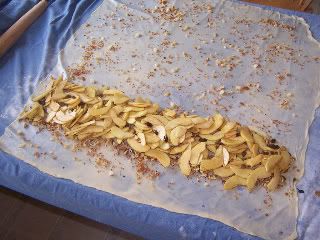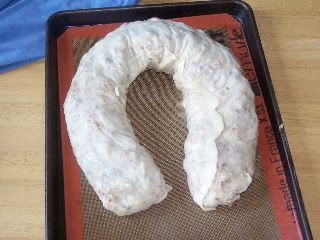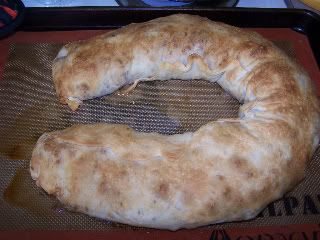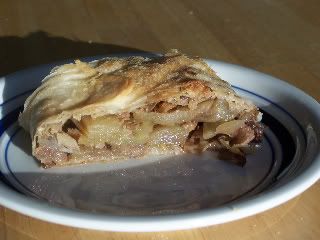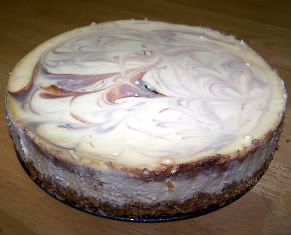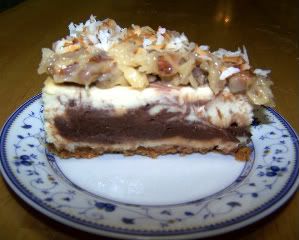This month I decided to join the ever growing circle of
Daring Bakers. The challenge this month was Pierre Hermes' Chocolate Eclairs. It was for chocolate glazed and chocolate filled eclairs. We had to keep one of the chocolate elements, but had the liberty to choose which one and what other flavors (if any) we wanted to introduce.
This was my first time for doing pretty much every part of the challenge: the chocolate glaze, pastry cream, and pastry dough. Oh, and I've never been much of a food photographer, so I'm learning about that as well.
I had to split this up into 2 days because of cooking time constraints with a baby and all.
Day 1I first started by
so I could make the
chocolate sauce and
glaze.

Now, I thought it a bit odd I'd have to make a chocolate
sauce in order to make the
glaze. It felt a little over the top. The glaze only needed 7 Tbsp. of sauce, so I cut the original sauce recipe in half. The sauce seemed to take FOR-EV-ER since you had to thicken it on low. I think I was sitting there stirring about 20 min. or so. The sauce really was essential to the glaze. The glaze was nice and pretty dark.
Will I make it a again? No. Took too long for my baking attention span!
I also made the

the first day.
I made a
vanilla pastry cream because Matt wanted it simple and not a chocolate overload.
I've been looking for the recipe I used, but I've misplaced it somewhere! I think it may have been a Julia Child recipe I found online though...
For my enjoyment, to a small portion, I added a little

I thought the orange would go nicely with the dark chocolate glaze.
It did.
I began on the stove top by

I then took it off the heat and added eggs in 1 at a time.

Don't forget to pipe the dough while it's still warm!
 (As an aside here, the recipe calls for the pastries to be baked on wax or parchment paper. I couldn't find my parchment paper, so I did a few on wax and most of them on the silpat. The wax paper started smoking and stinking up the house, so I quickly pulled the few off and baked them directly on the pan. They still worked out. The silpat worked very nicely, though.)
(As an aside here, the recipe calls for the pastries to be baked on wax or parchment paper. I couldn't find my parchment paper, so I did a few on wax and most of them on the silpat. The wax paper started smoking and stinking up the house, so I quickly pulled the few off and baked them directly on the pan. They still worked out. The silpat worked very nicely, though.)After 20 min. of baking, rotating, and propping the door with a wooden spoon,

Voila!
Now to combine all my efforts...I present to you The Eclair!
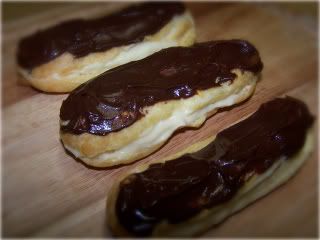
These were good. Matt's response after tasting them was,
"Yep. This is an eclair." We were happy with how they turned out, especially since it was my first try. It was a whole lot of steps and effort, though.
I probably won't be making them again any time soon.But I'm very glad I made them for this challenge.So, if you're feeling DARING, here is the recipe:(makes 20-24 Éclairs)
• Cream Puff Dough (see below for recipe), fresh and still warm
1) Preheat your oven to 375 degrees F (190 degrees C). Divide the oven into thirds by positioning the racks in the upper and lower half of the oven. Line two baking sheets with waxed or parchment paper.
2) Fill a large pastry bag fitted with a 2/3 (2cm) plain tip nozzle with the warm cream puff dough. Pipe the dough onto the baking sheets in long, 4 to 41/2 inches (about 11 cm) chubby fingers. Leave about 2 inches (5 cm) space in between each dough strip to allow them room to puff. The dough should give you enough to pipe 20-24 éclairs.
3) Slide both the baking sheets into the oven and bake for 7 minutes. After the 7 minutes, slip the handle of a wooden spoon into the door to keep in ajar. When the éclairs have been in the oven for a total of 12 minutes, rotate the sheets top to bottom and front to back. Continue baking for a further 8 minutes or until the éclairs are puffed, golden and firm. The total baking time should be approximately 20 minutes.
Notes:1) The éclairs can be kept in a cool, dry place for several hours before filling.
Assembling the éclairs:• Chocolate glaze (see below for recipe)
• Chocolate pastry cream (see below for recipe)
1) Slice the éclairs horizontally, using a serrated knife and a gently sawing motion. Set aside the
bottoms and place the tops on a rack over a piece of parchment paper.
2) The glaze should be barely warm to the touch (between 95 – 104 degrees F or 35 – 40 degrees C, as measured on an instant read thermometer). Spread the glaze over the tops of the éclairs using a metal icing spatula. Allow the tops to set and in the meantime fill the bottoms with the pastry cream.
3) Pipe or spoon the pastry cream into the bottoms of the éclairs. Make sure you fill the bottoms with enough cream to mound above the pastry. Place the glazed tops onto the pastry cream and wriggle gently to settle them.
Notes:1) If you have chilled your chocolate glaze, reheat by placing it in a bowl over simmering water, stirring it gently with a wooden spoon. Do not stir too vigorously as you do not want to create bubbles.
2) The éclairs should be served as soon as they have been filled.
Pierre Hermé’s Cream Puff DoughRecipe from Chocolate Desserts by Pierre Hermé(makes 20-24 Éclairs)
• ½ cup (125g) whole milk
• ½ cup (125g) water
• 1 stick (4 ounces; 115g) unsalted butter, cut into 8 pieces
• ¼ teaspoon sugar
• ¼ teaspoon salt
• 1 cup (140g) all-purpose flour
• 5 large eggs, at room temperature
1) In a heavy bottomed medium saucepan, bring the milk, water, butter, sugar and salt to the
boil.
2) Once the mixture is at a rolling boil, add all of the flour at once, reduce the heat to medium and start to stir the mixture vigorously with a wooden spoon. The dough comes together very quickly. Do not worry if a slight crust forms at the bottom of the pan, it’s supposed to. You need to carry on stirring for a further 2-3 minutes to dry the dough. After this time the dough will be very soft and smooth.
3) Transfer the dough into a bowl of a mixer fitted with the paddle attachment, or using your
handmixer or if you still have the energy, continue by hand. Add the eggs one at a time, beating after each egg has been added to incorporate it into the dough. You will notice that after you have added the first egg, the dough will separate, once again do not worry. As you keep working the dough, it will come back all together again by the time you have added the third egg. In the end the dough should be thick and shiny and when lifted it should fall back into the bowl in a ribbon.
4) The dough should be still warm. It is now ready to be used for the éclairs as directed above.
Notes:1) Once the dough is made you need to shape it immediately.
2) You can pipe the dough and the freeze it. Simply pipe the dough onto parchment-lined baking
sheets and slide the sheets into the freezer. Once the dough is completely frozen, transfer the
piped shapes into freezer bags. They can be kept in the freezer for up to a month.
Chocolate Pastry Cream Recipe from Chocolate Desserts by PierreHermé• 2 cups (500g) whole milk
• 4 large egg yolks
• 6 tbsp (75g) sugar
• 3 tablespoons cornstarch, sifted
• 7 oz (200g) bittersweet chocolate, preferably Velrhona Guanaja, melted
• 2½ tbsp (1¼ oz: 40g) unsalted butter, at room temperature
1) In a small saucepan, bring the milk to a boil. In the meantime, combine the yolks, sugar and cornstarch together and whisk in a heavy‐bottomed saucepan.
2) Once the milk has reached a boil, temper the yolks by whisking a couple spoonfuls of the hot milk into the yolk mixture.Continue whisking and slowly pour the rest of the milk into the tempered yolk mixture.
3) Strain the mixture back into the saucepan to remove any egg that may have scrambled. Place the pan over medium heat and whisk vigorously (without stop) until the mixture returns to a boil. Keep whisking vigorously for 1 to 2 more minutes (still over medium heat).Stir in the melted chocolate and then remove the pan from the heat.
4) Scrape the pastry cream into a small bowl and set it in an ice‐water bath to stop the cooking process. Make sure to continue stirring the mixture at this point so that it remains smooth.
5) Once the cream has reached a temperature of 140 F remove from the ice‐water bath and stir in the butter in three or four installments. Return the cream to the ice‐water bath to continue cooling, stirring occasionally, until it has completely cooled. The cream is now ready to use or store in the fridge.
Notes:1) The pastry cream can be made 2‐3 days in advance and stored in the refrigerator.
2) In order to avoid a skin forming on the pastry cream, cover with plastic wrap pressed onto the cream.
3) Tempering the eggs raises the temperature of the eggs slowly so that they do not scramble.
Chocolate GlazeRecipe from Chocolate Desserts by Pierre Hermé(makes 1 cup or 300g)
• 1/3 cup (80g) heavy cream
• 3½ oz (100g) bittersweet chocolate, finely chopped
• 4 tsp (20 g) unsalted butter, cut into 4 pieces, at room temperature
• 7 tbsp (110 g) Chocolate Sauce (recipe below), warm or at room temperature
1)In a small saucepan, bring the heavy cream to a boil. Remove from the heat and slowly begin to add the chocolate, stirring with a wooden spoon or spatula.
2) Stirring gently, stir in the butter, piece by piece followed by the chocolate sauce.
Notes:1) If the chocolate glaze is too cool (i.e. not liquid enough) you may heat it briefly
in the microwave or over a double boiler. A double boiler is basically a bowl sitting over (not touching) simmering water.
2) It is best to glaze the eclairs after the glaze is made, but if you are pressed for time, you can make the glaze a couple days ahead of time, store it in the fridge and bring it up to the proper temperature (95 to 104 F) when ready to glaze.
Chocolate SauceRecipe from Chocolate Desserts by Pierre Hermé (makes 1½ cups or 525 g)
• 4½ oz (130 g) bittersweet chocolate, finely chopped
• 1 cup (250 g) water
• ½ cup (125 g) crème fraîche, or heavy cream
• 1/3 cup (70 g) sugar
1) Place all the ingredients into a heavy‐bottomed saucepan and bring to a boil, making sure to stir constantly. Then reduce the heat to low and continue stirring with a wooden spoon until the sauce thickens.
2) It may take 10‐15 minutes for the sauce to thicken, but you will know when it is done when it coats the back of your spoon.
Notes: 1) You can make this sauce ahead of time and store it in the refrigerator for two weeks. Reheat the sauce in a microwave oven or a double boiler before using.
2) This sauce is also great for cakes, ice-cream and tarts.



